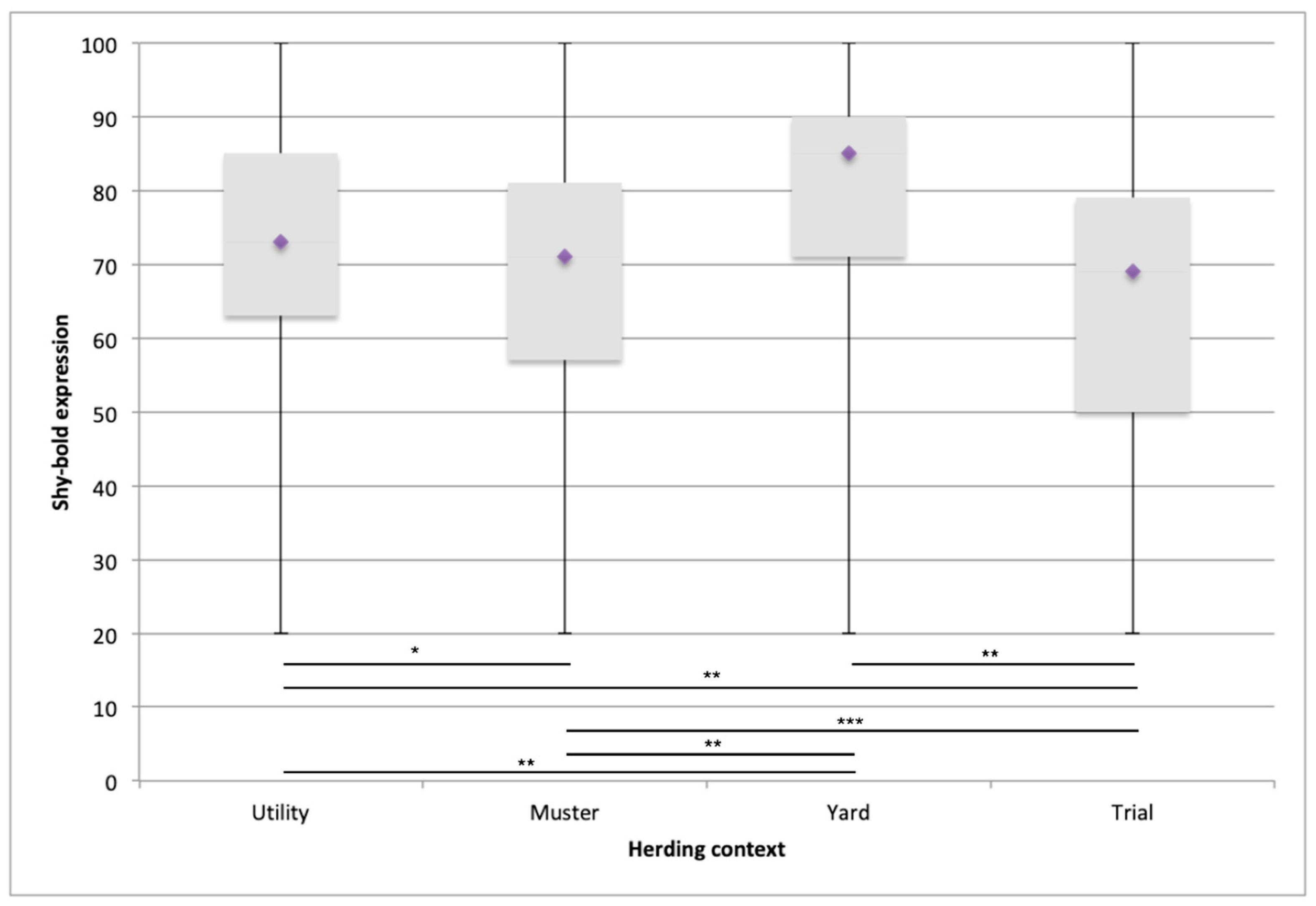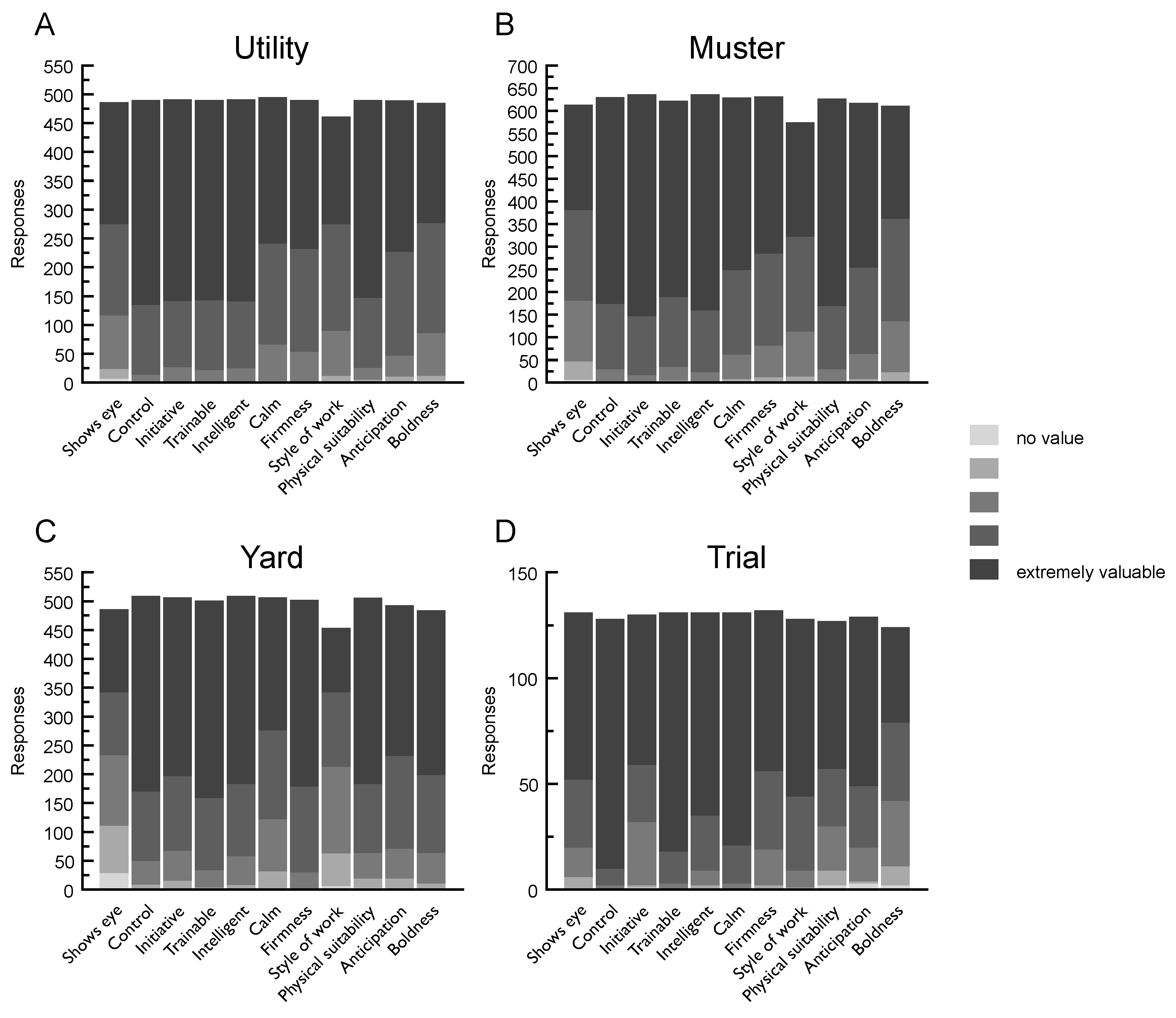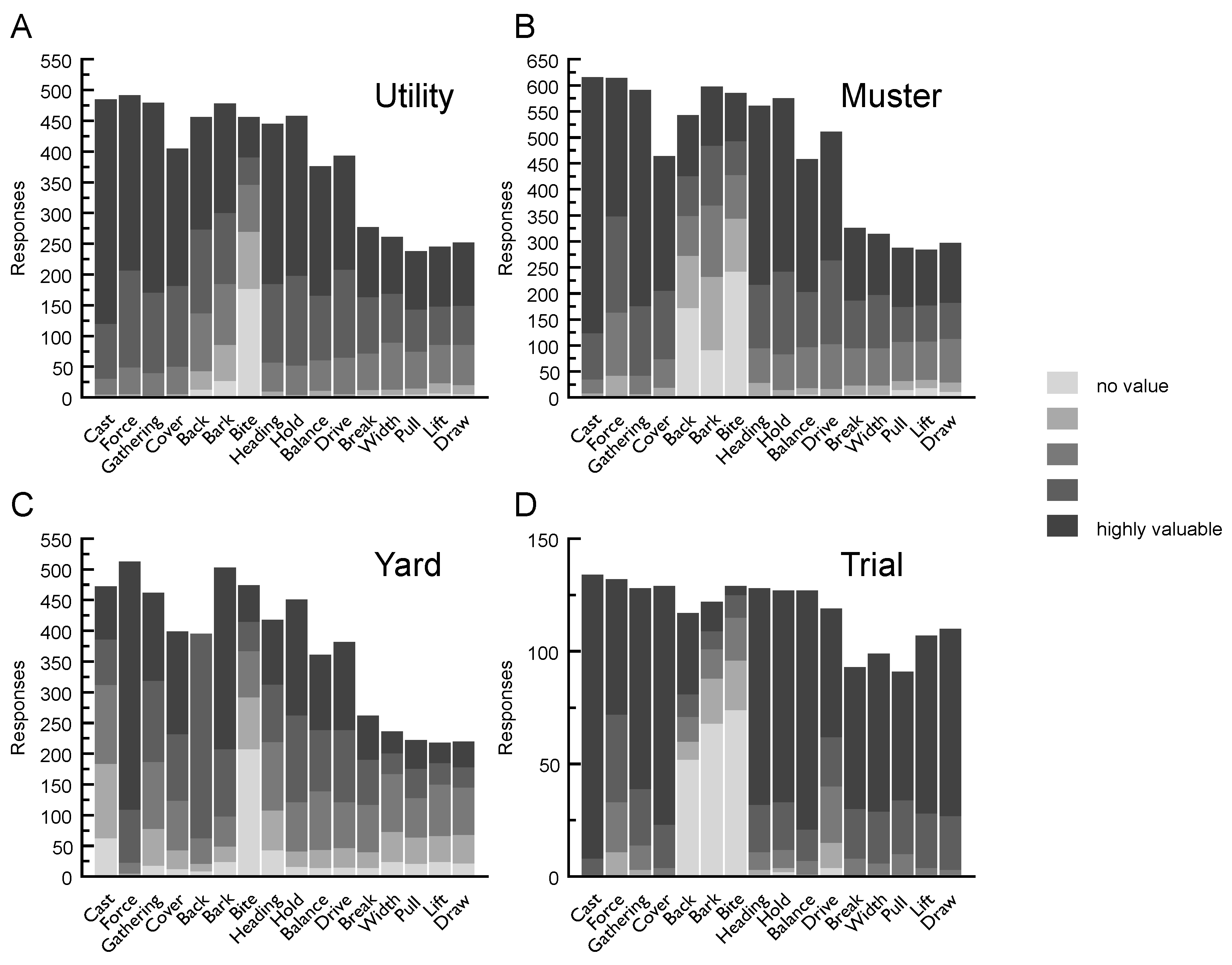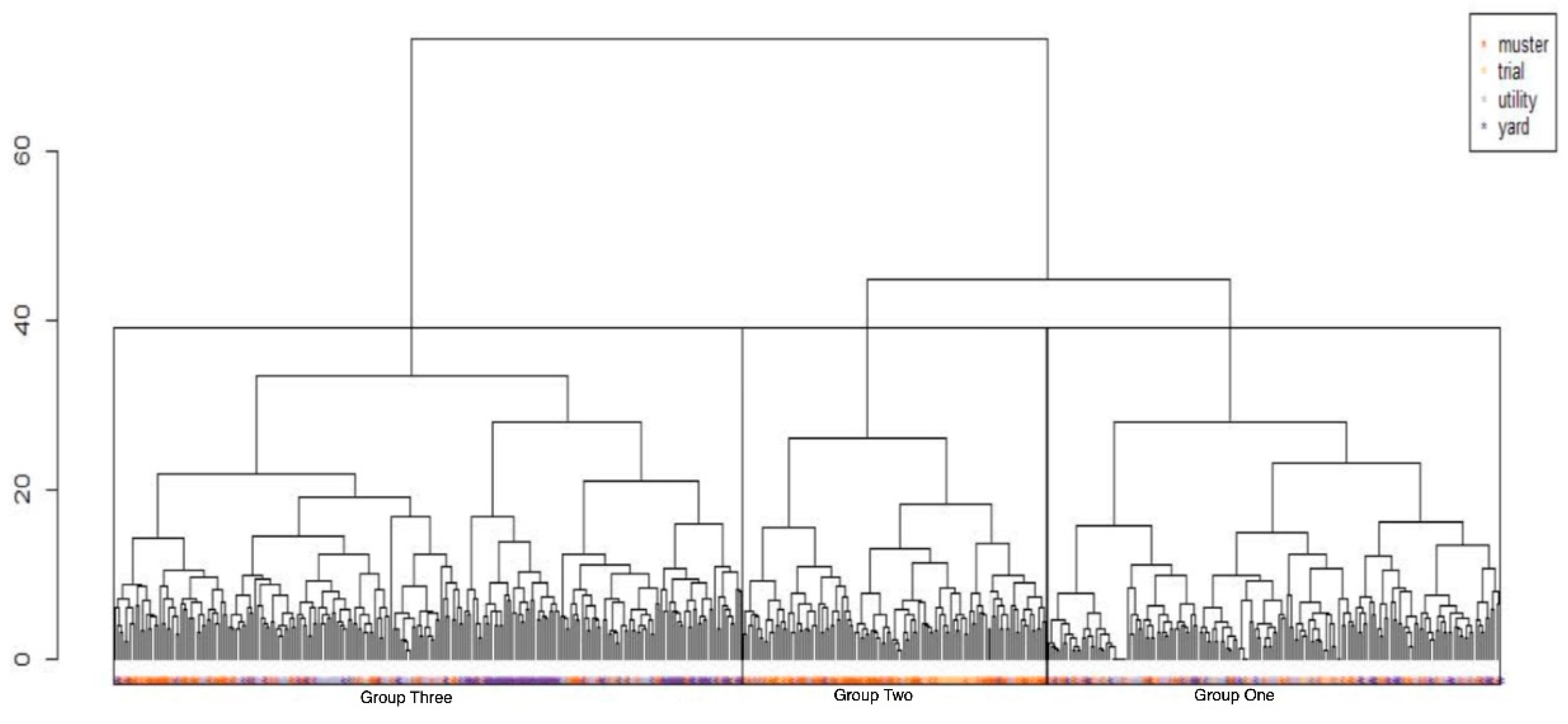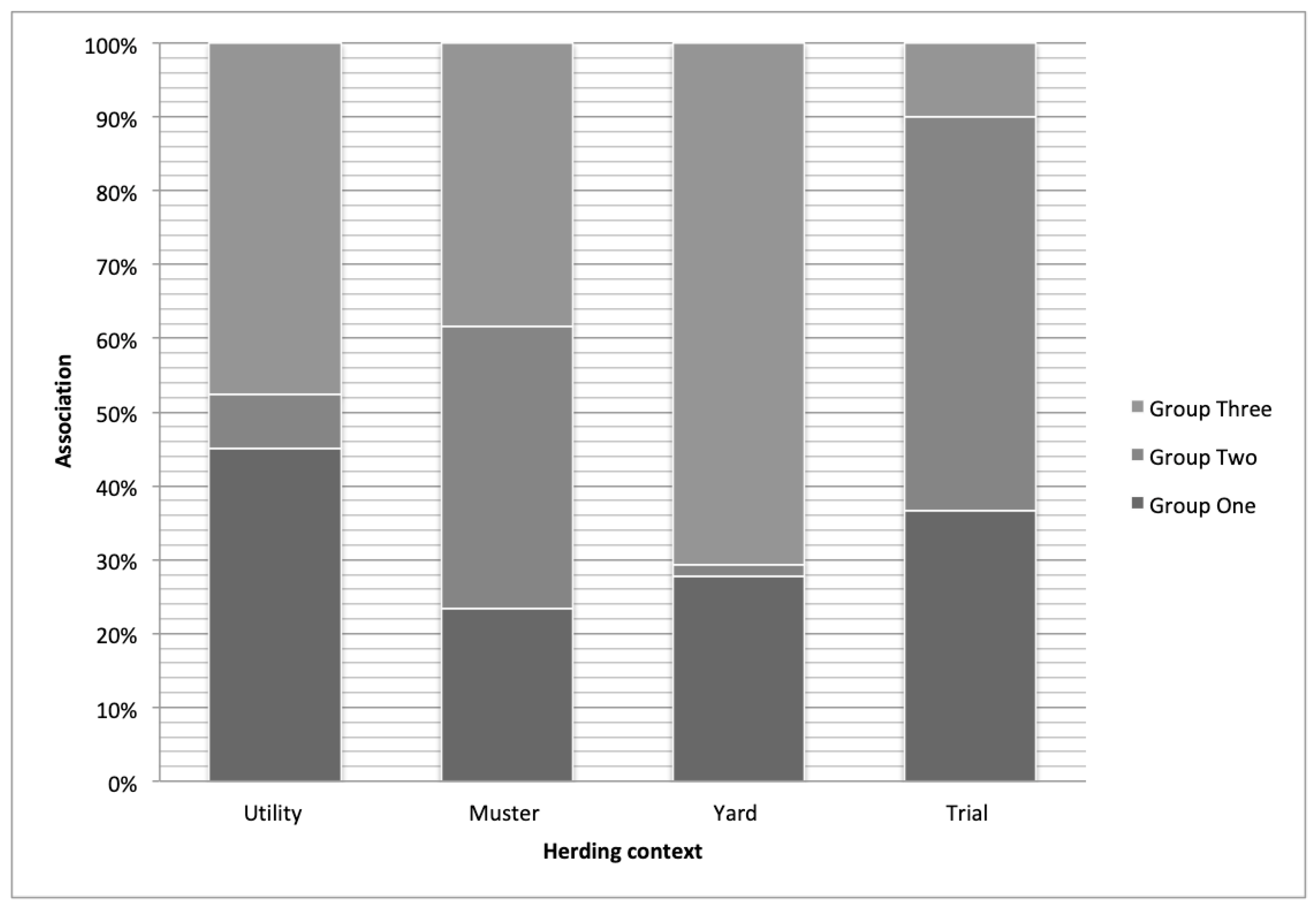1. Introduction
The national population of working livestock herding dogs in Australia has been estimated at more than 94,000 individuals [
1]. Over an average working career, the estimated economic value of these dogs’ work is over A
$40,000 per individual [
2]. Successful partnerships between dog and handler reflect the quality of the match between the personality and behaviour profile of the dog and the preferences, experience and skills of its handler as well as the perceived financial value of the dog [
3].
Livestock herding dogs are routinely used to move livestock in three over-arching contexts that are also used to label specific working skill-sets: utility (both paddock and yard), mustering (paddock and livestock routes) and yard (in and around sheds, sale-yards and transport vehicles). They are selected primarily for performance and health rather than morphological traits [
4], an approach that has resulted in the prevalence of a suite of behaviours thought to be stylised elements of the predatory sequence exhibited by
Canis lupus familiaris [
5,
6,
7].
Natural instinct, combined with opportunities to regularly practise and be reinforced for herding behaviours, is fundamental to any dog’s performance in a herding task. The unique triadic interaction of humans, dogs, livestock and sometimes handlers on horseback has been referred to as a ‘mutually adjusted system’ [
8]. Insufficient or poor quality training may jeopardise dog and livestock welfare and compromise learning outcomes [
9,
10,
11]. Investigations into handler–dog interactions during livestock herding training have focussed on moderating access to livestock through negative punishment (interrupting access to livestock) or positive reinforcement (allowing continued access to livestock) [
5,
12]. These operant techniques reveal the reinforcing value of access to livestock in dogs that have been selected to relish this sort of work [
13].
Data on the ease or difficulty with which livestock herding dog handlers can condition dogs to perform certain working behaviour traits may reveal areas in which trainer education may be especially beneficial. They may also identify which traits deserve a particular focus in breeding and selection to ensure livestock herding dogs can perform the task for which they are being bred.
Peer-reviewed studies on the behaviour of livestock herding dogs are rare (
see [
5,
8,
12,
14,
15,
16]) and, among them, few are easily transferable to the Australian context. Importantly, only two studies [
5,
8] defined the dogs used in their studies as working dogs or from working dog lines, rather than companion dogs of herding breeds. One Australian study, which was not subject to peer-review, examined the inheritance of the behavioural trait
eye (commonly defined as a dog’s ability to hold sheep together by staring at them) [
17]. It reported that, when using a six-point scale to score
eye, the 28 dogs tested were most likely to be scored as intermediate to or aligned with one of their parent’s scores.
Popular literature on livestock herding in Australia suggests that certain behavioural traits such as
eye,
force,
boldness,
anticipation and
cast are pivotal to successful herding ability [
18,
19]. However, the definition, interpretation, perceived value and relevance of these and other traits varies among authors [
17,
18,
20,
21,
22,
23,
24,
25]. For example, a recent study of eight Australian herding manuals identified a significant discordance in the frequency of the use of such popular terms [
26].
The current study used a questionnaire to identify the ideal position for a livestock herding dog on the shyness–boldness continuum, the value that handlers place in the ideal dog on the expression of five general attributes; 11 working attributes; 16 working manoeuvres and the ease with which dogs can be trained to show each of these in four distinct herding contexts. A central hypothesis for the current survey study was that respondents would, having some knowledge of innate versus learnt behaviours, report innate behaviours as being more difficult to train.
2. Materials and Methods
The ‘Australian Farm Dog Survey’ was designed to investigate the distribution of farm dogs in Australia, their usage, their management and the views of their owners along with demographic information relating to the breeder/handler (for other publications using this survey
see [
2,
3,
27]). In particular, respondents were asked about five general attributes, 11 working attributes and 16 working manoeuvres in their dogs. The questions were grouped within four herding contexts: utility, mustering, yard, and competition (3-sheep trial).
Prior to publication of the survey, popular working-dog training manuals were consulted and advice was sought from members of the Working Kelpie Council of Australia to ensure that the terminology in the survey was appropriate for the target audience. A pilot distribution of the survey to 125 participants led to some minor modifications prior to widespread distribution.
The online version of the survey was available over a three-month period from 10 March to 10 June 2013. All promotional materials relating to the survey indicated that a hard copy of the survey with a reply-paid envelope would be provided to participants if they requested one by telephone. Approval for this study was granted from the University of Sydney Human Research Ethics Committee (Approval number 15474).
The target population for the survey was livestock herding dog users across Australia. Participation was encouraged with entry into a prize draw to win commercial working-dog food at the end of the survey period. An introductory message gave participants the option to respond anonymously with an assurance of confidentiality were they to choose to leave their details to enter the prize draw.
A link to the online survey was posted on the websites of the University of Sydney [
28] Meat and Livestock Australia [
29] and the Working Kelpie Council of Australia (WKCA) [
30]. It was advertised through stories in multiple regional newspapers, on three nation-wide television programs and in two national agricultural magazines. The committee of the 2013 Casterton Kelpie Auction (one of Australia’s leading livestock herding dog auction events) promoted the survey in a mail-out to past and current vendors and purchasers. The researchers also recruited survey participants, in person, at livestock herding dog trials during the study period.
The online version of the survey was constructed using the survey system QSmart (Torque Management Systems Limited, Auckland, New Zealand). The entire questionnaire had a maximum of 143 items assigned to 10 sections. However, participants needed to answer fewer questions if they responded in the negative to questions about certain activities, such as breeding or trialling of dogs. The logic system of the online survey permitted the redirection of participants to questions of relevance. (To view the complete survey,
see [
31].
In Early et al. [
26], we defined working manoeuvres, working attributes (referred then as working skills) and general attributes: working manoeuvres represent a sequence of movements used in herding; working attributes reflect an ability used in herding; general attributes are personality traits ascribed to an individual. Where a trait might fit into both working and general attributes or might lie on the same spectrum (e.g.,
boldness and
cautiousness), the authors made a decision into which category it should be included, based on whether testing and exploring these relationships would identify, statistically, if they are valued in different ways.
Respondents were asked to indicate the ease with which 16 working manoeuvres in the typical working dog can be trained: cast, force, gathering, cover, backing, bark, bite, heading, hold, balance, drive, break, width, pull, lift and draw. They answered using a semantic differential-type 5-point rating scale. Descriptive phrases ‘extremely easy’ and ‘almost impossible’ were used at either extreme of the scale. Respondents were advised to not provide a rating for any working manoeuvre terms that they were unfamiliar with.
The same 16 working manoeuvres were used again in the next question, which asked the respondents to indicate how valuable they considered these behaviours in livestock herding dogs. Respondents were asked to answer this question separately for up to four herding contexts in which they had experience. These included three types of work, namely, utility (generally known among trainers as all-round), mustering, and yard, and one competition context referred to as trial (i.e., working trials, generally known among trainers as arena or 3-sheep trials). Answer options included a semantic differential-type 5-point rating scale, ranging from ‘no value’ to ‘highly valuable’. Respondents unfamiliar with any working manoeuvre terms were advised to not provide a rating.
The handlers were asked to score the value of 11 working attributes—shows eye, control, initiative (which we described as including working independently, keenness and willingness), trainable (including tractable), intelligent (including sagacious, brainy and clever), calm, firmness (including strength and power), style of work (including width), physical suitability (including stamina and durability), anticipation and boldness. These attributes’ values were recorded for each working and competition environment within which the respondent had handled livestock herding dogs. Answer options included a semantic differential-type 5-point rating scale. Descriptive phrases ‘no value’ to ‘extremely valuable’ were used at either end of the scale. Respondents unfamiliar with any working attribute terms were advised to not provide a rating.
Respondents were asked to indicate the degree of expression of five general attributes they would expect to be present in the ideal dog for the working and competition environments in which they had experience. These attributes were
excitability,
trainability,
motivation and confidence,
friendliness and
cautiousness. They were drawn, and slightly modified from, the “Big Five” personality traits identified by Ley et al. [
32]. Respondents answered using a semantic differential-type 5-point rating scale ranging from ‘none’ to ‘a very high degree’ at each end point with ‘a moderate degree’ at the midway point. Respondents unfamiliar with any general attribute terms were advised to not provide a rating.
The final question asked handlers to indicate, on a 100-point visual analogue scale, the balance of shyness–boldness expression they would expect the ideal dog to exhibit for each herding context in which they had experience, where zero was maximum shyness and 100 was maximum boldness. Specifically, they were asked: Please indicate, by moving the sliding scale/marking on the scale, the balance of shyness and boldness that the ideal dog would exhibit. As a guide, the descriptive phrases ‘extremely shy’ and ‘extremely bold’ were used at either extreme of the scale. Respondents unfamiliar with the concept of shyness–boldness expression were advised to not provide a rating.
Genstat Version 16 (VSN International, Hemel Hempstead, UK) was used for statistical analysis of shyness–boldness expression results. REML analysis was performed using the variate means of shyness–boldness expression for each herding context: utility, mustering, yard and trial. This permitted assessment of whether differences in ideal shyness–boldness expression across the four contexts were significant.
Individual handler optima on the shyness–boldness expression in the ideal dog for each of the four herding contexts were gathered and descriptive statistics collated. The same approach was taken to the amount of five general attributes in the ideal dog; the 11 working attributes in their dogs; the 16 working manoeuvres and the training ease of each working manoeuvre.
To explore the influence of context on handler preferences, a hierarchical cluster analysis based on Gower distance (as all variables in this study were ordinal; this corresponded to Manhattan distance) was conducted using the hclust function of the R statistical and computing software [
33].
A Pearson’s chi-squared test was performed to assess the significance of the results.
4. Discussion
Although surveys of owners and/or experts have been previously used to develop behavioural profiles of companion dog breeds [
34,
35], to our knowledge, this is the first to assess the relative value of personality and working traits in livestock herding dogs.
By identifying the most valuable working and personality traits across multiple herding contexts, the current results help to show how these traits influence successful movement of livestock while also identifying traits that could enhance both context-specific and general breeding programs. Genetic analysis from the hunting dog sector in Sweden has shown that, for at least six traits, if Best Linear Unbiased Prediction breeding values were used instead of phenotype, genetic gain would be 89% higher [
36]. With the sequencing of the canine genome [
37], molecular genetics provides the opportunity to identify suitable livestock herding dogs at an earlier age than behavioural assessment currently offers.
Of the four herding contexts surveyed, mustering was selected as the context in which most respondents had experience with handling livestock herding dogs. This was followed by yard and utility, with only a small number of respondents involved in the trial (competition) environment. These distributions reflect prevalent Australian working conditions in that livestock are often collected over large areas of farmland prior to being managed within yards. Whether this Australian distribution of potential respondents and the current resultant data are similar in other large-scale livestock-producing countries requires further investigation.
4.1. Shy–Bold
The ideal reported balance of shyness–boldness expression significantly differed across the four herding contexts. Livestock herding dogs working in the yard context were considered by respondents to require a higher level of boldness than in the utility and mustering contexts, followed by the trial context. However, the middle 50% of responses overlapped between each context. This finding reflects the necessary blend of confidence, motivation, composure and resilience that presumably make up the term boldness, the so-called super trait that yard dogs require to be successful in this close-up, threatening, high risk environment. The expression of boldness appears to be a simple way for respondents to differentiate between the type of dog required between each herding context.
4.2. General Attributes
For general attributes, handlers and breeders across all herding contexts reported that the ideal dog has a high degree of
trainability,
motivation and confidence and
friendliness. The cluster analysis also identified similarities across the three groups for the amount preferred of these traits. The results for
excitability highlighted one of the more interesting findings for the general attributes group. Across all contexts and the three cluster analysis groups, respondents identified this as the ‘Goldilocks’ trait—not too little, not too much, but ‘just right’; the term Goldilocks principle or effect is referred to in other research fields including economics and education to describe contexts that seek balance [
38,
39]. Finding a balance for
excitability is not unique to livestock herding dogs, for example it is also noted in guide dogs [
40]. However, improvements in selective breeding for this trait may assist future research about behavioural tendencies being undertaken among service dogs [
41,
42].
Respondents’ preference for a dog that is easy to work with, through long hours, and often as the handler’s only companion in conducting their work has implications for the welfare of these dogs. Specifically, livestock herding dogs that do not meet handlers’ expectations of being ‘trainable, motivated, confident and friendly’ could be at more risk of becoming so-called behavioural wastage (being discarded from the industry because of poor performance related to behaviour, rather than physical inadequacy) [
43]. ‘A moderate degree’ of
excitability and
cautiousness was preferred, reflecting respondents’ awareness of the potential for high levels of these traits to compromise the successful working performance of a dog. This preference for trait-specific expressions of certain qualities is a complex finding. A common difficulty in breeding or selection of livestock herding dogs is consistency between what one handler or breeder and another considers to be ‘the right amount’ of a trait expressed in a dog.
4.3. Working Attributes
As far as working attributes are concerned, the current study revealed both similarities and differences between the four herding contexts and confirmed, by the cluster analysis, the key working characteristics preferred and valued by handlers. Across all contexts, the high values assigned to
control and
trainable indicate the importance of these traits in allowing handlers and breeders to breed, rear and train the best dogs for each herding context. While dogs working at a distance from their handler are not unique to livestock herding, what is specialised to livestock herding dogs is the concurrent gathering and movement of livestock to the handler. The understanding of respondents that dogs in this context pose a risk to themselves (e.g., placing themselves in dangerous positions leading to injury) and the livestock (e.g., injuring livestock due to poor herding technique) should not be underestimated. For both mustering and utility contexts, respondents reported that dogs with
initiative,
intelligence and
physical suitability were of most value to them. These traits reflect the complex and demanding nature of work in these contexts and the requirement for handlers to both direct their dogs, when needed, and rely on them to perform independently, as required. In the yard context, most respondents also assigned high value to
firmness and
physical suitability.
Boldness, a personality trait often referred to in the peer-reviewed canine behaviour literature (e.g., [
44,
45]), was considered of less value than the other working attributes in the utility, mustering and trial contexts, yet was one of the highest value attributes in the yard context. These results reflected those obtained from the shyness–boldness expression question. Similarly,
shows eye, a core attribute of herding dogs that has clear analogues in the predatory sequence [
8], was considered of high value only in the trial context. These apparent anomalies suggest that the demands of herding work peak within the broad yard context, which often requires dogs to move fearful livestock at a close distance, through tight spaces, repeatedly.
4.4. Working Manoeuvres
The value of the 16 working manoeuvres across the four herding contexts revealed some key similarities between the four herding contexts. In the utility, mustering and trial contexts, cast, force, gathering, cover, heading, hold, balance and drive were consistently of high value to respondents whereas force and bark were of extreme value to respondents compared to the other manoeuvres. While these results are not surprising, they represent a selection of manoeuvres on which breeders or handlers may focus to ensure their dogs meet expectations when working. Notable exceptions were bite and backing. Across all four contexts, many respondents assigned ‘no value’ for bite while backing was assigned ‘no value’ by many respondents in the mustering and trial contexts, reflecting their relative unhelpfulness in these contexts. Additionally, throughout the cluster analysis, bite, being the trait of least value, revealed awareness among respondents that the ideal dog should show limited expression of this trait.
The current study clearly identified manoeuvres whose reported value differed from one context to the next. For example, cast was rated as the most valuable in utility, mustering and trial contexts, but as only of general value in the yard context. Many respondents consistently rated bite as having ‘no value’ across each context.
The cluster analysis provided further insight into respondents’ thoughts on working manoeuvres. Among handlers, there appear to be two main groups who require all-rounder type dogs. The first group (Group One) were those who have a clear preference for a select group of traits they need to perform the work with a focus on the utility context. This group also appears to have a keen interest in the skills their dogs need to be successful. The second group (Group Three) were those handlers who want ‘jack of all trades’ dogs that possess a broad range of working manoeuvres and consider most manoeuvres to have only moderate value. This group reported primarily on the yard context. Further studies are required to differentiate between the first group, who may be experienced students of livestock herding dogs with well-developed ideas of the most valuable traits to have a successful dog, and the second group, who seem to represent the majority of yard-based Australian livestock herding dog handlers who are primarily outcomes-focused. These results have provided an additional layer to this survey’s findings: that, while there appears to be a move towards a need for specialist livestock working dogs on the whole, generalities remain and there is still a need for those who primarily work in the yard context to have dogs with a broad, albeit average, skill set.
4.5. Ease of Training Working Manoeuvres
When respondents were asked how easy or difficult it is to train a group of working manoeuvres, the hypothesis was that respondents of the survey would select innate behaviours as being more difficult to train. The results indicate that, overall, the manoeuvres were neither easy nor difficult to train. This may reflect our use of scales that had insufficient granularity to detect real differences between ease of training. Two manoeuvres that appear to be elements of the predatory sequence,
force and
hold, were reported by respondents to be easier to train than the other manoeuvres. It is possible that some handlers with a good understanding of livestock herding dog behaviour may find innate behaviours easier to train or shape, while others may credit their own training skills for any apparent ease of training certain innate behaviours. For accomplished trainers, creating scenarios for a livestock herding dog to practice and trigger these innate behaviours may make them relatively easy to train by simply fine-tuning a natural behaviour. In Australia, mean failure rates of herding dogs in training have been estimated to be at least 20% [
2]. Improving understanding of the practical application of behavioural science findings as they pertain to livestock herding dogs may boost training outcomes [
46]. This approach has met with considerable success in horse training through the nascent discipline of equitation science [
47]. Additionally, identifying consistently successful trainers with low failure rates, who can provide assistance to fellow trainers through sharing their knowledge, may also have merit.
While the current results provide some helpful information on the relative value of working and personality traits in the four herding contexts, they do contain some limitations. Among all three non-competition contexts, the manoeuvres
break,
width,
pull,
lift and
draw were unfamiliar to many respondents in the working context. This is most probably because these terms are often used in competition and technical literature but rarely in the practical, working contexts. An additional limitation is that the current survey did not explore the specific reasons for why individual manoeuvres were either of high or low value to each respondent or why some respondents did not assign a rating or score to a given quality. While the terms presented in the current survey were identified as those most commonly used in relevant manuals [
26], there is scope to further investigate why these working manoeuvres provide value within each herding context.
Furthermore, due to the large number of questions, it was apparent that respondents missed answering parts of questions, developed survey fatigue or were not familiar with some of the terms or traits presented. Improved survey design, including attempts to verify whether respondents deliberately failed to answer part of any given question, may assist in reducing missing data. A further limitation that we acknowledge as a potential source of lost detail among the data arose in the general attributes questions where, for consistency with Ley et al. [
32], the personality dimensions
motivation and
confidence were grouped together. Because of this, it was not possible to determine whether respondents were selecting just one or both terms in their response. As such, this result should be interpreted with some caution. The question on training ease of the 16 working manoeuvres attempted to tease out respondents’ understanding of the difference between innate and learnt behaviours in relation to livestock herding. While the results indicate some variability in understanding by respondents, a published analysis of a different section of results from the same survey, focusing on dogmanship, found a general lack of understanding of learning theory and training principles among the current respondents [
27]. Further investigation into survey respondents’ understanding of the behavioural underpinnings of these working manoeuvres may assist interpretation of this section of the survey.
There is limited research analysing the effect of sex on behavioural traits in livestock working dogs. While data on sex in relation to the behavioural traits in this study was not collected,
confidence and
boldness are examples where sex differences could be explored in future studies. Additionally, sex differences in training ease among livestock working dogs may provide interesting comparisons to other working dog sectors [
48].
